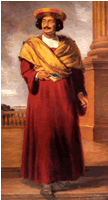 Early life Early life
Rammohun Roy was born in the village called Radhanagore of Khanakul, Hooghly a district in West Bengal on May 22, 1772. His father Ramakanta Roy was an orthodox Brahmin and his mother was Tarini Devi. Rammohun was educated in Persian, Arabic, Sanskrit & Bengali. He studied the works of great scholars and evolved into a free thinker. This also led him to leave home on more than once occasion and finally be driven away from his home by his father.  On one of these occasions he landed up in Tibet to study Buddhism but again incurred the wrath of the teacher and his disciples owing to his radical free thinking and protests against Lama worshipping and idolatry. On one of these occasions he landed up in Tibet to study Buddhism but again incurred the wrath of the teacher and his disciples owing to his radical free thinking and protests against Lama worshipping and idolatry.
After the death of his father in 1803 he moved down to Murshidabad where he published a Persian treatise with an Arabic preface entitled, "Tuhfat-ul-Muwahhidin" or "A Gift to Monotheism" in 1805. This book gave a great deal of offence to the orthodox Muslims. During his tenure as the Dewan of Rangpur district under the East India Company he used to hold discussion meetings in the evening with members of Hindus, Muslims and Jains. In addition to a knowledge of the ancient Vedantic literature he also studied the Tantric works with the aid of Hariharananda Tirthaswami. He also mastered the Kalpa Sutra and other Jain texts. He also improved his knowledge of English with private study and took a keen interest in European politics and followed the cause of the French Revolution.
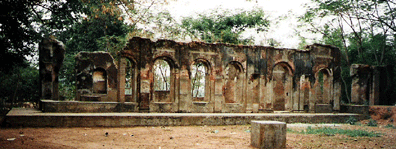
Ancestral House at Radhanagore
Atmiya Sabha
In 1814 Rammohun came and settled in Calcutta and in 1815 founded the Atmiya Sabha - an association for the dissemination of the religious truth and the promotion of free discussions of theological subjects. Amongst the rich and influential who gathered around him at that time were Prince Dwarkanath Tagore of Jorasanko, Prasanna Kumar Tagore of Pathuriaghata, Kali Nath and Baikuntha Nath Munshi of Taki, Raja Kali Shankar Ghoshal of Bhukailash etc. But the meetings of the Sabha were not the only means to propagate his doctrines. Here recital and expounding of Hindu scriptures were done and Govinda Mala would sing songs composed by Rammohun. In 1819 there took place a celebrated debate between Rammohun and Subrahmanya Sastri on the subject of idol worship in presence of the leading citizens of Calcutta including Raja Radhakanta Deb and Rammohun vanquished his adversary.
Publications & Literary Works
During the course of his researches into the domain of Sanskrit literature Rammohun was struck by the purity of the monotheistic doctrines of the Upanishads which were in sharp contrast with the prevailing corruptions of Hindu idolatry. He decided to publish the Upansihads with his own preface and translations. These books produced an intense and wide spread agitation in the Indian society.  He published the Vedanta (1815), Ishopanishad (1816), Kathopanishad (1817), Moonduk Upanishad (1819), The Precepts of Jesus - Guide to Peace and Happiness (1820), Sambad Kaumudi - a Bengali newspaper (1821), Mirat-ul-Akbar - Persian journal (1822), Bengali Grammar (1826), Brahmapasona (1828), Brahmasangeet (1829) and The Universal Religion (1829). Ramohun was also instrumental in setting up the Hindoo College in 1817 in Calcutta, which was renamed as Presidency College in 1856 when it was taken over by the government. He also tried his utmost to repeal the Press Censorship Act of 1823, and even appealed to the King of England. Though his efforts proved fruitless at that time - the Act was finally repealed in 1835. Rammohun was the first to compose Dhrupad songs in Bengali in 1828. He felt the need of Dhrupad songs - noted for their depth, grandeur, simplicity and absence of decorative tonal effusion - for his Brahmo Sabha meetings. Tappa and Thungri, he felt, were much too frolicsome for such occasions. He composed thirty-two songs in Dhrupad style and introduced them in Brahmo Sabha gatherings. He published the Vedanta (1815), Ishopanishad (1816), Kathopanishad (1817), Moonduk Upanishad (1819), The Precepts of Jesus - Guide to Peace and Happiness (1820), Sambad Kaumudi - a Bengali newspaper (1821), Mirat-ul-Akbar - Persian journal (1822), Bengali Grammar (1826), Brahmapasona (1828), Brahmasangeet (1829) and The Universal Religion (1829). Ramohun was also instrumental in setting up the Hindoo College in 1817 in Calcutta, which was renamed as Presidency College in 1856 when it was taken over by the government. He also tried his utmost to repeal the Press Censorship Act of 1823, and even appealed to the King of England. Though his efforts proved fruitless at that time - the Act was finally repealed in 1835. Rammohun was the first to compose Dhrupad songs in Bengali in 1828. He felt the need of Dhrupad songs - noted for their depth, grandeur, simplicity and absence of decorative tonal effusion - for his Brahmo Sabha meetings. Tappa and Thungri, he felt, were much too frolicsome for such occasions. He composed thirty-two songs in Dhrupad style and introduced them in Brahmo Sabha gatherings.
Work with Unitarians
Mr. William Adam, a young Baptist missionary who had come over from England, mentioned openly in 1821 that he was converted into 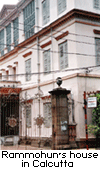 Unitarian doctrines through the influence of Rammohun Roy. Rammohun wrote in the Brahminical magazine where he assailed the Trinitariansim of Christianity and tried to prove that it was no better than the Hindu polytheism. This gave rise to great scandal amongst the orthodox Christian community. Rammohun also helped William Adam to set up a Unitarian mission in Calcutta in 1823. Till 1828 Rammohun regularly attended the Unitarian Sunday service of Mr. Adam. In fact he called himself to be a Hindu Unitarian, and he silenced his critics by saying, "Because I feel already weary of the doctrine of Man God or God Man frequently inculcated by the Brahmins in pursuance of their corrupt traditions and the same doctrine of Man God though preached by another body of priests cannot effectually tend to excite my anxiety to listen to it. Because Unitarians believe, profess, inculcate the doctrine of divine unity, a doctrine which I find firmly maintained both by Christian scriptures and by our most ancient writings commonly called the Vedas." Unitarian doctrines through the influence of Rammohun Roy. Rammohun wrote in the Brahminical magazine where he assailed the Trinitariansim of Christianity and tried to prove that it was no better than the Hindu polytheism. This gave rise to great scandal amongst the orthodox Christian community. Rammohun also helped William Adam to set up a Unitarian mission in Calcutta in 1823. Till 1828 Rammohun regularly attended the Unitarian Sunday service of Mr. Adam. In fact he called himself to be a Hindu Unitarian, and he silenced his critics by saying, "Because I feel already weary of the doctrine of Man God or God Man frequently inculcated by the Brahmins in pursuance of their corrupt traditions and the same doctrine of Man God though preached by another body of priests cannot effectually tend to excite my anxiety to listen to it. Because Unitarians believe, profess, inculcate the doctrine of divine unity, a doctrine which I find firmly maintained both by Christian scriptures and by our most ancient writings commonly called the Vedas."
Foundation of Brahmo Samaj
On 6th Bhadra, 20th August 1828 the first Samaj was opened at the house of Feranghi Kamal Bose which was rented for the occasion. Meetings of the Samaj were held every Saturday.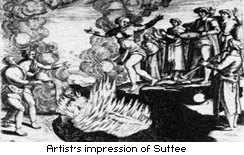 This new theistic service was called Brahma Sabha or "One God Society." This attracted the masses and had a large number of sympathisers. Also during this time Lord William Bentinck declared the abolition of Sutte act on 4th December 1829, due to Rammohun's tireless agitation against this evil practice. The orthodox Hindus under Raja Radhakanta Deb formed a rival association called Dharma Sabha to ridicule and protest against Rammohun's actions. In the midst of this furious party contests Rammohun opened his new church on 11th Magh, or 23rd January 1830. In 1825 he also opened the Vedanta College for the teaching of the monotheistic doctrines of the Upansihads. This new theistic service was called Brahma Sabha or "One God Society." This attracted the masses and had a large number of sympathisers. Also during this time Lord William Bentinck declared the abolition of Sutte act on 4th December 1829, due to Rammohun's tireless agitation against this evil practice. The orthodox Hindus under Raja Radhakanta Deb formed a rival association called Dharma Sabha to ridicule and protest against Rammohun's actions. In the midst of this furious party contests Rammohun opened his new church on 11th Magh, or 23rd January 1830. In 1825 he also opened the Vedanta College for the teaching of the monotheistic doctrines of the Upansihads.
Visit to Europe
Rammohun left the management of his Samaj to his well wishers and left for the shores of England in 1830. His main object was to plead before the authorities of the East India Company the case of the ex - emperor of Delhi who had made Rammohun his ambassador and conferred upon him the title of Raja or king. object was to plead before the authorities of the East India Company the case of the ex - emperor of Delhi who had made Rammohun his ambassador and conferred upon him the title of Raja or king. 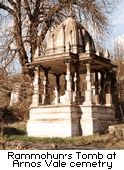 His other object was to baffle his adversaries who were trying to get Bentinck's Suttee act repealed and also to be present in the Britsh parliament for the deliberations of the renewal of the charter of East India Company. In England he met among others the historian William Roscoe, and the philosopher Jeremy Bentham. In London he was publicly received at the Annual meeting of the Unitarians of England. He also presented 3 papers on the Revenue System of India, Judicial System of India and the Material Condition of India before a committee of the House of Commons. He was also present at the coronation of George IV and was personally presented to the king. He visited France towards the end of 1832 where he had the honour of dining with the French king more than once. His other object was to baffle his adversaries who were trying to get Bentinck's Suttee act repealed and also to be present in the Britsh parliament for the deliberations of the renewal of the charter of East India Company. In England he met among others the historian William Roscoe, and the philosopher Jeremy Bentham. In London he was publicly received at the Annual meeting of the Unitarians of England. He also presented 3 papers on the Revenue System of India, Judicial System of India and the Material Condition of India before a committee of the House of Commons. He was also present at the coronation of George IV and was personally presented to the king. He visited France towards the end of 1832 where he had the honour of dining with the French king more than once. 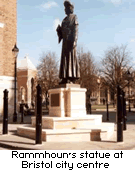 In 1833 he returned to England where he saw that the parliament turn down the appeal of his adversaries against the abolition of Suttee and also the renewal of the In 1833 he returned to England where he saw that the parliament turn down the appeal of his adversaries against the abolition of Suttee and also the renewal of the 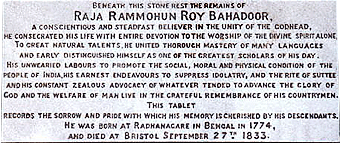 charter of the East India Company. He visited Bristol in 1833 at the invitation of Miss Mary Carpenter and other Unitarian friends. Rammohun breathed his last on 27th September 1833 in Bristol at the Beech House charter of the East India Company. He visited Bristol in 1833 at the invitation of Miss Mary Carpenter and other Unitarian friends. Rammohun breathed his last on 27th September 1833 in Bristol at the Beech House 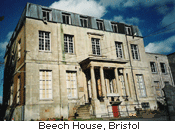 in Stapleton Grove. He was buried in the garden of Stapleton Grove and ten years later his mortal remains were laid to rest at Arnos Vale cemetery by Prince Dwarkanath Tagore. The design of the mausoleum was done by William Prinsep. The Bristol city council now honours Rammohun with a statue, built in 1997 at the city centre. in Stapleton Grove. He was buried in the garden of Stapleton Grove and ten years later his mortal remains were laid to rest at Arnos Vale cemetery by Prince Dwarkanath Tagore. The design of the mausoleum was done by William Prinsep. The Bristol city council now honours Rammohun with a statue, built in 1997 at the city centre.
Netaji Subhas Chandra Bose in his The India Struggle called Rammohun Roy "the apostle of a religious revival" in India. He writes "...He urged a return to the original principles of Vedantism and for a total rejection of all the religions and social impurities that had crept into Hinduism in later times. He also advocated an all-round regeneration of the social and national life and the acceptance of all that is useful and beneficial in the modern life of Europe. Raja Rammohun Roy therefore stands out against the dawn of the new awakening in India as the prophet of the new age."
In his inaugural address read at the Sri Ramkrishna Centenary Parliament of Religion and published in the Modern Review in April 1937, Dr Brajendranath Seal said:
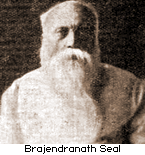 "Rammohun Roy, the precursor and in a very real sense the father of Modern India, sought the Universal Religion, the common basis of the Hindu, Moslem, Christian and other faiths. He found that each of the national religions was based on this common faith with a certain distinctive historical and cultural embodiment. "Rammohun Roy, the precursor and in a very real sense the father of Modern India, sought the Universal Religion, the common basis of the Hindu, Moslem, Christian and other faiths. He found that each of the national religions was based on this common faith with a certain distinctive historical and cultural embodiment.
"It is fundamental to note that Rammohun Roy played two roles in his own person:
As an universalist he formulated the creed of what was called Neo-theophilanthropy (a new love of God and man) on positive and constructive lines. He construed the Gayatri on this basis. And, strange to say, this Hindu became one of the forefathers of the Unitarian creed and worship in the West, the other three being Prince, Priestly and Canning.
As a Nationalist Reformer, Rammuhun Roy had a three-fold mission:
As a Hindu Reformer, he gave a Unitarian reaction of the Hindu Shastras from the Vedanta and the Mahanirvana Tantra
As a Moslem defender of he faith, he wrote the Tuhfat-Ul-Muwahhiddin and the Monozeautul Adiyan, which were polemical works, and
As a Christian, he gave a Unitarian version of the entire body of scriptures, old and new, in his controversies with the Christian Missionaries."
See Rammohun Roy's speech before the Unitarian Association, London.
See Rabindranath Tagore's lecture on the centenary of Raja Rammohun Roy. |